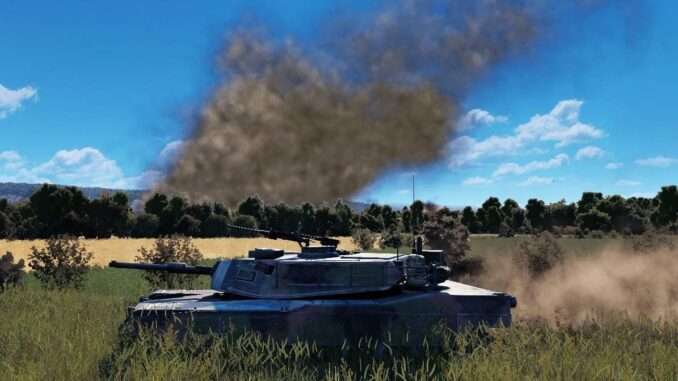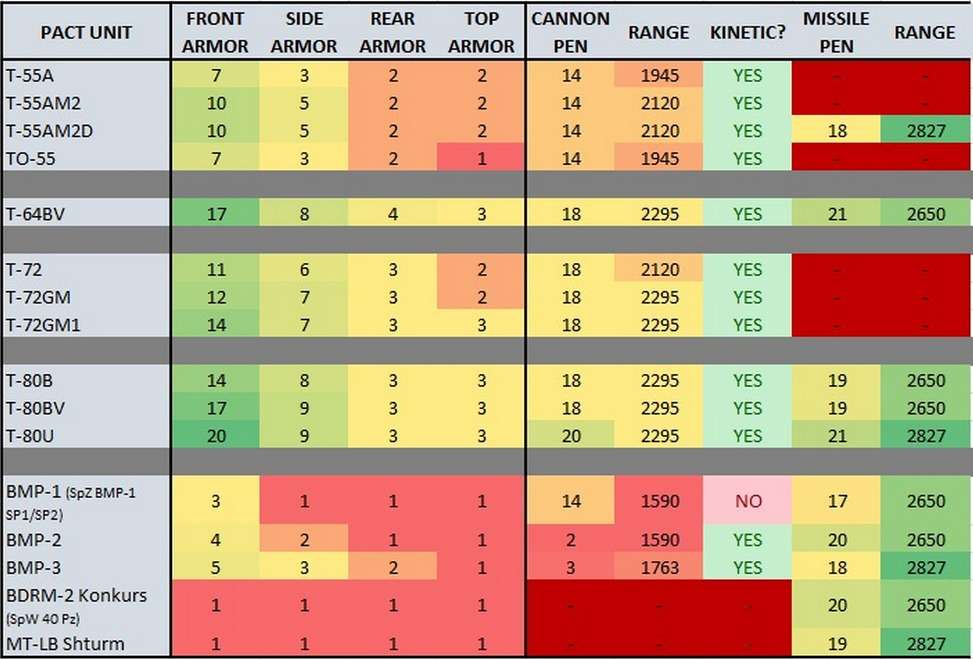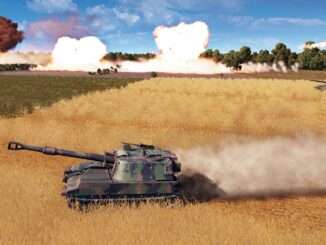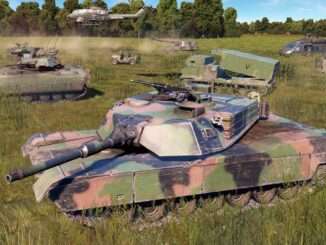
Guide to Tanks, Artillery and Aircrafts
Tanks
This section covers combat involving armored vehicles, such as tanks.
This includes kinetic shells, armor penetration, accuracy and damage calculation.
Armor Piercing
Tanks, when firing at enemy armor, will use a kinetic-type shell called Armor Piercing (AP). These shells are fired at very high speeds. They will use their speed to pierce the armor of an enemy target.
In the Unit Information Panel, a weapon will show if it can fire AP rounds when it displays the Kinetic icon.
It is important to note that an AP shell will lose power along the way.
An AP shell will contain the maximum amount of power when exiting a tank gun. This means that with an AP shell, the closer you are t o an armored target on the battlefield, the more damage you will be able to do.
To be exact: in WARNO, when an AP shell is fired, it loses one point of Penetration Power for every 350 meters traveled.
Armor
Armored units have localized armor plating at different parts of the vehicle. A unit’s armor is divided into Front, Side (both flanks), Rear, and Top. In general, an armored unit frequently has the heaviest armor applied to the Front.
An AP shell must penetrate the thickness of a unit’s Armor to cause damage.
Keep in mind to having an armored unit always face the enemy with the thickest portion of its armor.
Damage Calculation
Each vehicle has a damage level ranging from 0% to 100%. Consider this a vehicle’s “health.” Beyond 100% damage, a vehicle unit is destroyed.
A shell or round with a Penetration Power lower than the Armor Value of a target unit will be unable to damage it.
The Smart Targeting Tool, which can be seen when targeting an enemy unit, will tell you if the shot will be inefficient. The tool will also provide feedback on the distance that needs to be covered to be able to penetrate the target and do damage.
As soon as a shell can penetrate the opponent’s armor, it does the following percentage of damage:
Damage Percentage = (AP Value- Armor) 12 + 1
Note: if the target has no armor, the damage is worth 2 x the AP value.
If the target has an Armor of 1, the damage is worth 1 x the AP value.
For example, we are firing an AP shell with a Penetration Power of 14 (on impact) at a target with an Armor Value of 3.
Damage = (14-3)/2 + 1 = 6.5 thus 65% damage.
Accuracy Calculation
Some vehicles can shoot on the move, while others cannot. You can check a unit’s capabilities in the weapon statistics of the Information Panel.
- The Motion icon means the weapon can be fired while on the move. This applies to both Infantry and Vehicle weapons.
- The Motion icon means the weapon can be fired while on the move. This applies to both Infantry and Vehicle weapons.
- The Stationary icon means the weapon needs to be aimed and fired while stationary. This applies to both Infantry (crew-served) and Vehicle weapons.
Some advanced units can retain an Accuracy while shooting, which is almost identical to being stationary. Other units lose almost all Accuracy while firing on the move.
Shooting in motion and shooting while stationary is indicated by the changing color of the crosshair in the Smart Targeting Tool.
Once a shell is fired, the crew will reload the weapon. Depending on the results of the first shots, the chances of hitting subsequent shots might be improved.
If the shot successfully hits the target, the crew keeps the firing solution and will continue to hit with subsequent shots.
Use of HEAT shells
Some shells (more generally rockets or missiles) use shaped-charged explosive warheads, called HEAT for High-Explosive Anti-Tank, which is capable of piercing armor. Because their penetration performance relies on the explosive energy of the warhead rather than kinetic energy, HEAT warheads do not need to be launched at high speed. In other words, the shell does not lose power with distance.
Damages
The calculation is exactly the same as for AP shells:
- (AP Value – Armor) / 2 + 1
Anti-tank missiles
There are two main elements to know when using an anti-tank missile.
The first thing is to know what is the targeting system of the missile and the second what is the guidance system of the missile once it has been fired.
Targeting system
Most missiles use targeting systems that require the vehicle to be stationary. More advanced missiles can be fired in motion.
Guidance system
Manual or semi-automatic
The missile is guided and operated manually or semi-automatically. The missile after launch requires the constant intervention and control input of the operator.
Semi-active radar
The firing control is carried out thanks to the electronics of the vehicle or aircraft which fired the missile. This means that the unit does not need to be stopped during the flight of the missile. This means that the unit can only fire one missile at a time.
Fire and forget
Fire-and-forget Missile. After launching, the guidance of the missile no longer requires the active intervention of the operator. This means that the unit can fire another missile a few seconds after the first one has left.
Missile installation time
The time to fire the missile is one thing and the time to reload is another. On some vehicles, reloading the missile(s} can take several minutes in reality, On other vehicles, the missiles are placed on a rack and ready to be fired one after the other.
It is therefore wise to look at the vehicle and see how many missiles can be fired before they have to be reloaded.
Artillery
Artillery represents a very strong mode of combat on the battlefield.
Because artillery allows to project firepower anywhere on the battlefield. Indeed, it does not have any problem of vision or distance.
In practice, there are different types of artillery.
Mortars
Mortars are small units capable of firing quickly at short range targets.
Mortar fire is characterized by excellent accuracy at its medium range and optimal aiming and firing time. However, as soon as it is necessary to fire beyond its average range, its accuracy becomes increasingly poor.
The mortar can generally fire smoke
Howitzer
The howitzer’s fire remains extremely accurate all along its course and allows to hit targets at very large distances. Unfortunately, its aiming time is particularly long. The howitzer can generally fire smoke
The MLRS
This artillery is a multiple rocket launcher. These launchers are particularly slow to aim and to fire. Their precision is poor (the platform starts to move after the launch of the first rockets) . Note that they are however perfectly capable of saturating large areas. Finally, a rather notable difference with the other available artillery pieces lies in the flexibility with which you can compose the rockets: HE, incendiary or anti-tank ammunition.
Aircrafts
The aircrafts are accessible from the air call interface. Their number is limited to 9 at the same time. To call a plane, simply left click on one of the planes and then left click on the terrain. The plane will immediately take off and join the combat zone through the corridor indicated by the arrow “air corridor”. To reach the combat zone, the aircraft will take a time indicated in its information panel. The time depends on its speed.
Once on the ground, the plane has a certain amount of fuel that allows it to stay for a certain time to carry out missions. Once its fuel is exhausted, the aircraft leaves the combat zone immediately and returns to its base.
Once at the airport, the aircraft will fly back, refuel and perform all refueling actions once there. The aircraft will also make any necessary repairs before it can be operational again.
Particularity of the aircraft
- ECM: electronic countermeasures are intended to occult or deceive radar or other enemy search or pointing sensors. The value indicated reduces the accuracy of enemy missiles.
- Turn radius: The minimum radius the aircraft can turn.
- Travel time: The time it takes the aircraft to travel from the airport to the combat zone.
Clearing out of the area
At any time we can order our aircraft to evacuate the combat zone and return to the airport. The evacuation time is not immediate and the aircraft, once ordered, becomes uncontrollable.
The planes evacuate automatically when they have no more ammunition.
Different types of aircraft
What distinguishes aircraft from each other is both their flight characteristics, the power of the engine, but also all the electronics on board, but in practice, we distinguish the different types of aircraft according to the missions they can be assigned.
Interceptors
Armed with long or short-range missiles, these aircraft have the task of intercepting anything that flies into the combat zone. These aircraft have the advantage of being very fast and can therefore be used very quickly. Long-range missiles are generally much faster and less maneuverable and are fired from a distance, while the agility of short-range missiles allows them to reach targets making tight movements.
Bombers
These planes are capable of carrying a very large bomb tonnage under their wings. The bomber’s mission is to drop all its bombs at the indicated position and to leave the area immediately afterwards.
We note that the bombers can be loaded with several types of bombs:
HE, napalm or cluster in anti-tank mode.
Ground attack aircraft
These aircraft are specialized in supporting ground troops. These aircraft fly at very low speed and are able to make very short turns in order to make a maximum of passes over the battlefield.
They can be equipped with rockets, anti-tank missiles and short-range anti-aircraft missiles to hunt down helicopters. It should also be noted that these aircraft are often equipped with a destructive nose gun.
Anti-radar aircraft
These aircraft are specialized in the Suppression of Enemy Air Defenses (SEAD). this mission consists in actions to suppress enemy surface-based air defenses, including surface-to-air missiles (SAMs) and anti-aircraft artillery. These aircraft are generally equipped with a very important ECM capacity
Multipurpose aircraft
The last type of aircraft in the list is the multipurpose aircraft. A plane capable of doing everything, it is generally less specialized.
Vehicles Charts
Pact Vehicles Chart
Click to enlarge…

NATO Vehicles Chart
Click to enlarge…






Be the first to comment